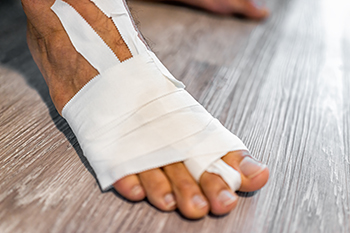
Turf toe is a sprain of the metatarsophalangeal, or MTP, joint, which connects the base of the big toe to the foot. This injury typically occurs when the big toe bends upward beyond its normal range, damaging the surrounding ligaments and tissues of the plantar complex. Symptoms of turf toe include pain, swelling, bruising, and reduced ability to push off with the toe. Turf toe injuries are grouped into three categories. Grade 1 involves stretching of the soft tissue, resulting in mild tenderness. Grade 2 involves a partial tear, causing more pain, swelling, and limited joint movement. Grade 3 is the most severe, with a complete tear of the soft tissue, often preventing weight-bearing on the toe. Turf toe is frequently experienced by athletes who play on artificial surfaces, especially those who wear lightweight shoes. It can affect gymnasts, dancers and other active people, as well. If you have symptoms of a turf toe injury, it is suggested that you schedule an appointment with a podiatrist for an exam and appropriate treatment options.
Toe pain can disrupt your daily activities. If you have any concerns, contact Leonard Talarico, DPM of Georgia. Our doctor can provide the care you need to keep you pain-free and on your feet.
What Causes Toe Pain?
Most severe toe pain is caused due to a sports injury, trauma from dropping something heavy on the toe, or bumping into something rigid. Other problems can develop over time for various reasons.
Toe pain can be caused by one or more ailments. The most common include:
- Trauma
- Sports injury
- Wearing shoes that are too tight
- Arthritis
- Gout
- Corns and calluses
- Hammertoe
- Bunions
- Blisters
- Ingrown toenails
- Sprains
- Fractures (broken bones)
- Dislocations
When to See a Podiatrist
- Severe pain
- Persistent pain that lasts more than a week
- Signs of infection
- Continued swelling
- Pain that prevents walking
Diagnosis
In many cases the cause of toe pain is obvious, but in others, a podiatrist may want to use more advanced methods to determine the problem. These can range from simple visual inspections and sensation tests to X-rays and MRI scans. Prior medical history, family medical history, and any recent physical traumatic events will all be taken into consideration for a proper diagnosis.
Treatment
Treatments for toe pain and injuries vary and may include shoe inserts, padding, taping, medicines, injections, and in some cases, surgery. If you believe that you have broken a toe, please see a podiatrist as soon as possible.
If you have any questions please feel free to contact our office located in Pooler, GA . We offer the newest diagnostic tools and technology to treat your foot and ankle needs.